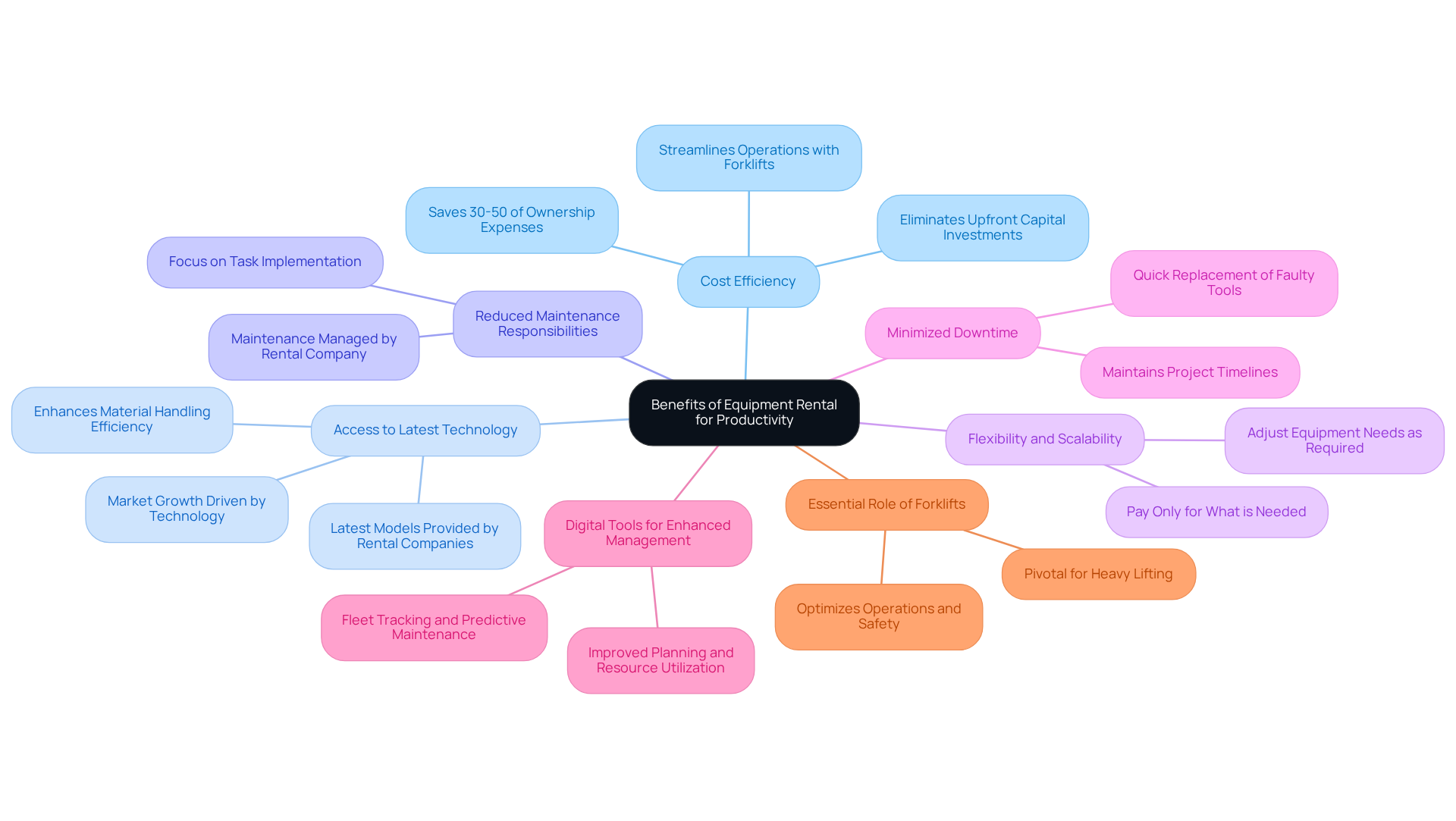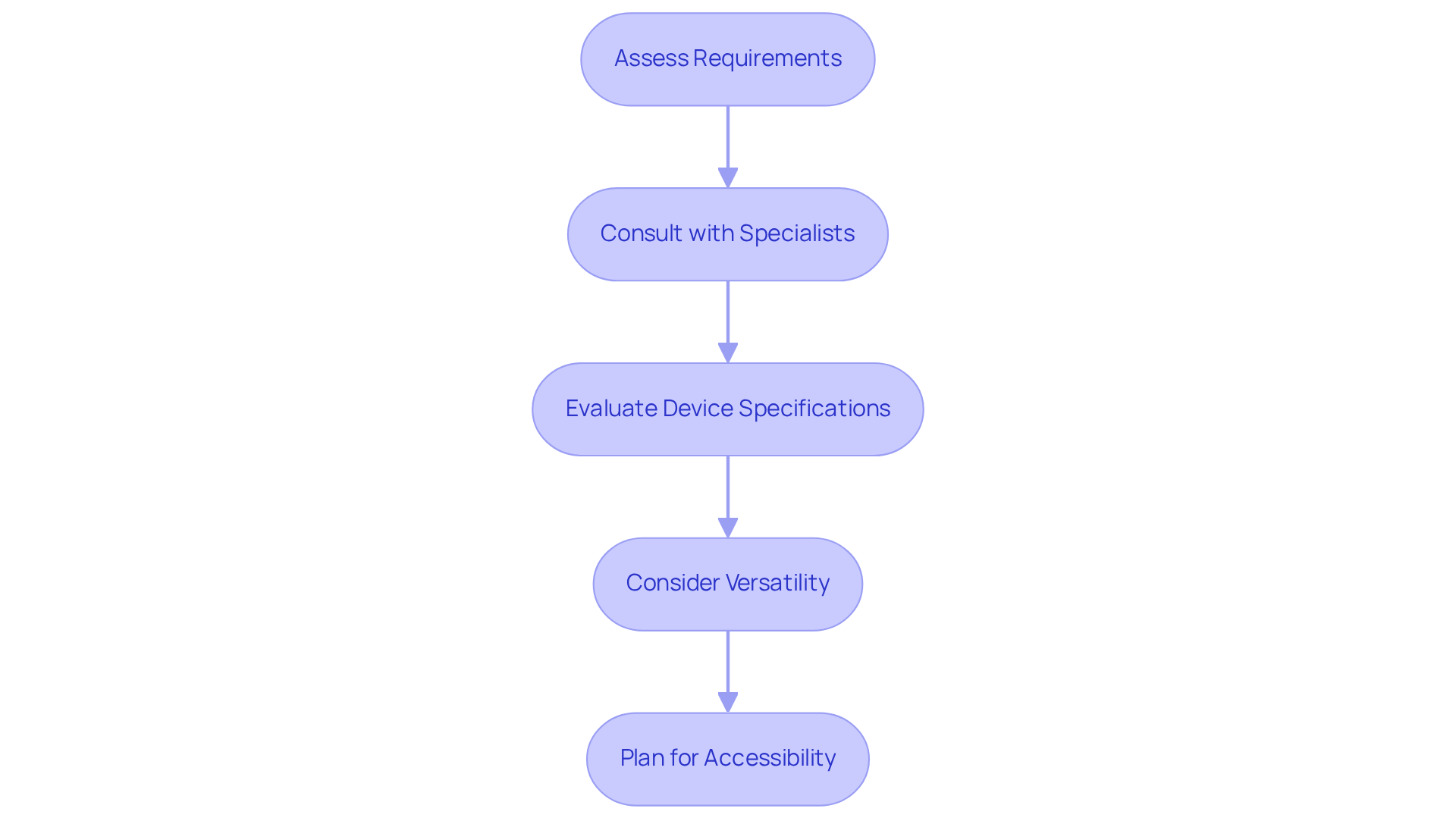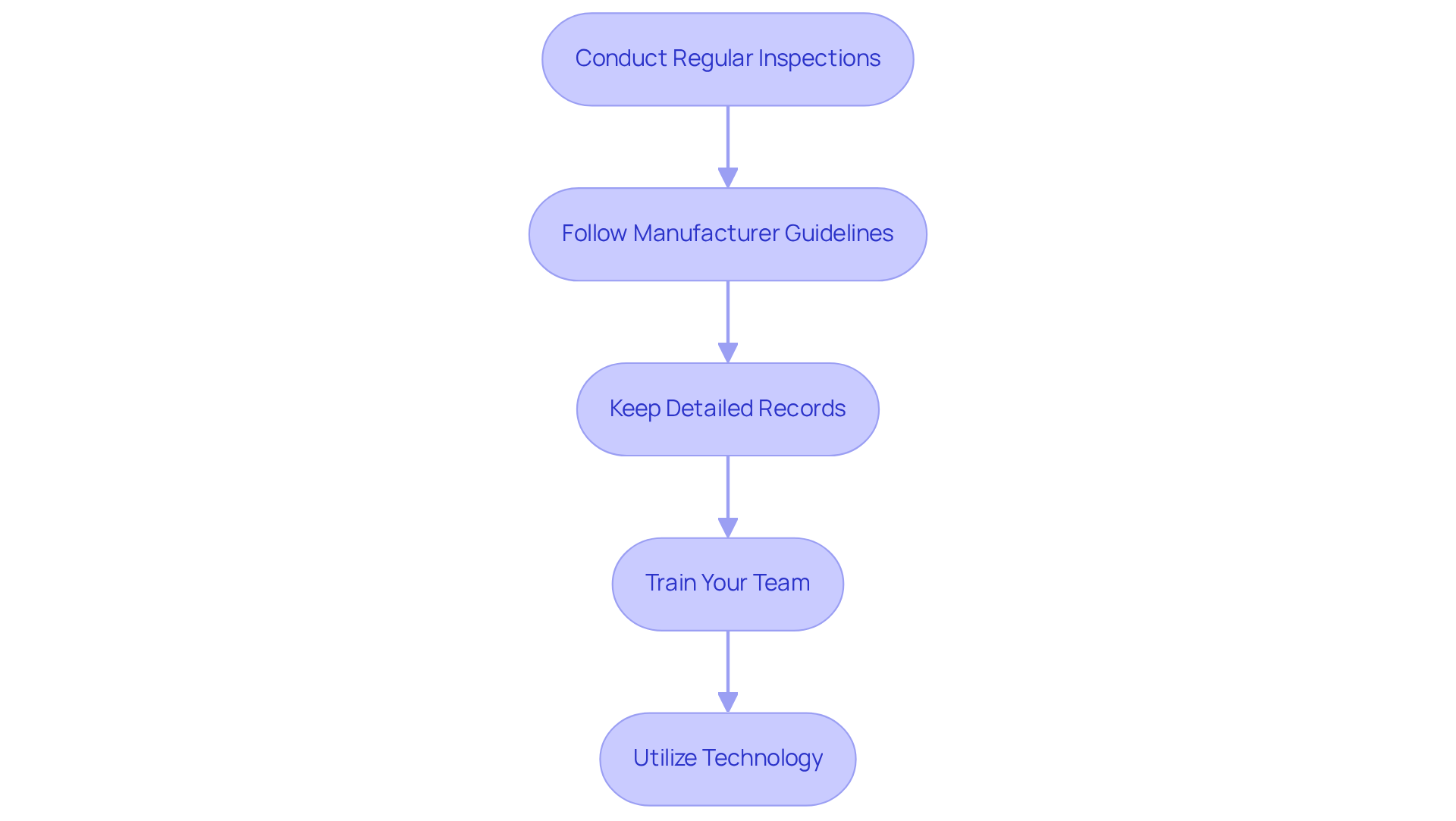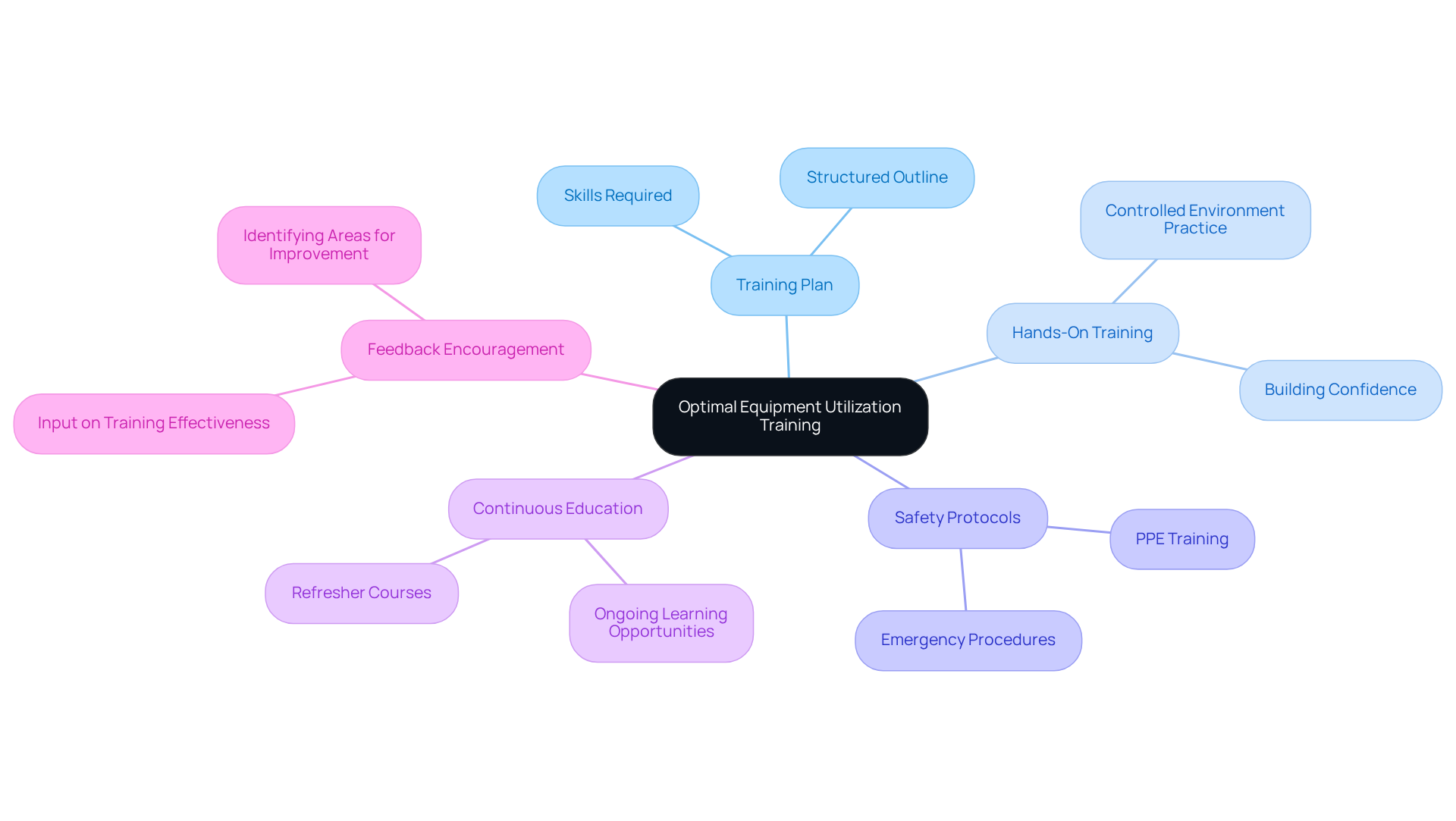Overview
Effective equipment rental strategies significantly enhance productivity by delivering cost efficiency, access to cutting-edge technology, and reduced maintenance responsibilities. This allows businesses to concentrate on their core tasks. Renting equipment minimizes upfront costs, offers flexible solutions tailored to specific project needs, and incorporates digital tools for improved fleet management. All these factors contribute to increased operational efficiency, making equipment rental a smart choice for modern businesses.
Key Highlights:
- Equipment rental offers cost efficiency by saving businesses 30-50% on ownership expenses, allowing funds to be redirected to other areas.
- Access to the latest technology through rental services ensures teams utilise the most effective tools, crucial for operational efficiency.
- Renting equipment minimises maintenance responsibilities as rental companies handle repairs, allowing teams to focus on their core tasks.
- Flexibility in rental agreements allows companies to adjust equipment needs based on project demands, optimising resource allocation.
- Quick replacement of faulty rental tools minimises downtime, helping to maintain project timelines and reduce costs.
- Digital tools in equipment rental improve fleet management and resource utilisation, contributing to overall productivity gains.
- Choosing the right equipment involves assessing project needs, consulting experts, and ensuring specifications meet operational requirements.
- Implementing regular inspections, following manufacturer guidelines, and maintaining detailed records enhances equipment management and safety.
- Training programmes for staff are essential for optimal equipment utilisation, improving safety, efficiency, and reducing maintenance costs.
- Continuous education and feedback loops foster a culture of engagement and performance improvement among team members.
Introduction
Effective equipment rental strategies can be a game changer in the construction and building sectors, providing a pathway to enhanced productivity and operational efficiency. By leveraging the advantages of renting tools—ranging from cost savings to access to the latest technology—businesses can streamline their processes and concentrate on what truly matters: executing projects on time and within budget. As the demand for efficient equipment rental continues to grow, the challenge of selecting the right tools and implementing successful management practices also intensifies. How can companies navigate this landscape to maximize productivity while minimizing costs and downtime?
The right equipment rental strategies not only enhance operational efficiency but also empower businesses to adapt swiftly to changing project demands. By utilizing the latest technology, companies can ensure they are equipped with reliable tools that meet their specific needs. Furthermore, renting equipment allows for flexibility, enabling businesses to scale their resources according to project size and duration. This adaptability is crucial in an industry where time is money and efficiency is paramount.
However, the selection process can be daunting. Companies must assess their unique requirements and evaluate the available options carefully. To aid in this process, it is beneficial to consider customer testimonials and case studies that highlight the reliability and quality of various rental services. In addition, understanding the features and benefits of each tool can significantly influence decision-making.
Ultimately, the goal is to foster a seamless integration of rented equipment into existing workflows, which can lead to significant time and cost savings. By prioritizing effective management practices and making informed choices, businesses can navigate the complexities of equipment rental with confidence. Now is the time to take action—explore your options and elevate your operational efficiency today.
Understand the Benefits of Equipment Rental for Productivity
Equipment rental presents a multitude of advantages that play a crucial role in enhancing productivity through effective equipment rental in the building and associated sectors. Among these key benefits are:
-
Cost Efficiency: Renting tools eliminates the need for substantial upfront capital investments, allowing businesses to allocate funds to other critical areas. This flexibility can improve cash flow and reduce financial strain, with studies indicating that rental machinery can save businesses between 30-50% of total ownership expenses. Forklifts, in particular, enhance this cost efficiency by decreasing the necessity for various tools for lifting and transporting materials, streamlining operations and minimizing expenses.
-
Access to Latest Technology: Rental companies frequently provide the latest models and technologies, ensuring that your team has access to the most efficient and effective tools available. This is especially significant as the construction machinery rental market is projected to reach USD 98.29 billion by 2034, driven by technological advancements and the rising demand for contemporary tools. Utilizing the latest forklifts can enhance efficiency by improving material handling processes.
-
Reduced Maintenance Responsibilities: When machinery is rented, the rental company typically manages maintenance and repairs. This arrangement allows your team to concentrate on task implementation rather than maintenance, which is essential for enhancing productivity through effective equipment rental. Forklifts, essential for heavy lifting, require regular maintenance, which is handled by the rental company, further alleviating your team's burden.
-
Flexibility and Scalability: Renting provides companies with the ability to adjust their equipment requirements according to task demands, ensuring they only pay for what they need at the right time. This flexibility is crucial in a market where construction needs can vary significantly. Forklifts can be rented as necessary, facilitating swift adjustments to scopes of work without the financial commitment of purchasing.
-
Minimized Downtime: Rental tools can be quickly replaced if faulty, reducing inactivity and helping maintain timelines. The ability to swiftly acquire alternative machinery, such as forklifts, is vital in enhancing productivity through effective equipment rental, especially in a sector where delays can lead to increased costs. Reliable access to forklifts ensures that material handling continues smoothly, preventing bottlenecks in project timelines.
-
Digital Tools for Enhanced Management: The integration of digital tools within the equipment rental industry is transforming how businesses manage their fleets. Enhanced fleet tracking and predictive maintenance capabilities support enhancing productivity through effective equipment rental, allowing for improved planning and resource utilization, which further contributes to productivity gains. These tools also help monitor the performance of forklifts, ensuring they are used efficiently.
-
The Essential Role of Forklifts: Forklifts are pivotal in enhancing building efficiency and safety. From lifting heavy items to moving tools on construction sites, their presence is crucial for optimizing operations and ensuring that tasks are completed on schedule and within budget. Businesses can significantly improve their operational efficiency and reduce costs by enhancing productivity through effective equipment rental.
By recognizing these advantages and understanding the challenges faced by the tool rental sector, such as supply chain interruptions and labor shortages, companies can make informed decisions about their rental strategies, ultimately leading to enhanced efficiency and successful outcomes.

Select the Right Equipment for Your Project Needs
Choosing the appropriate tools for your endeavor is essential for enhancing efficiency and reducing expenses. To ensure effective equipment rental strategies, consider the following essential steps:
-
Assess Requirements: Begin by thoroughly evaluating the scope and specific needs of your undertaking. Consider the type of work, materials involved, and the timeline for the endeavor. This critical step is vital, as insufficient evaluation can lead to significant budget overruns, with research indicating that poor resource management can elevate project expenses by as much as 71.5%.
-
Consult with Specialists: Engage with tool rental experts at EZ Rental, who possess in-depth knowledge of the available items. Their insights can assist you in selecting the most appropriate tools for your tasks, helping to prevent costly mistakes. For instance, they can offer tailored recommendations based on your project details, significantly enhancing operational efficiency.
-
Evaluate Device Specifications: Ensure that the equipment meets the necessary specifications for your project. Key factors to consider include load capacity, power requirements, and compatibility with other tools. This thorough assessment helps avoid delays caused by machinery deficiencies, which can account for 30-40% of construction cost overruns. EZ Equipment Rental prioritizes reliability, providing high-quality tools that meet these specifications to effectively support your operations.
-
Consider Versatility: Whenever possible, opt for multi-purpose tools. This approach not only reduces the number of rentals needed but also contributes to cost savings. For example, loaders, which represent 38.2% of all machinery owned by construction firms, demonstrate adaptability in various tasks, making them a preferred option for numerous projects. Renting a forklift near you in Dallas offers unparalleled flexibility, allowing you to adapt to changing project needs without substantial upfront investments.
-
Plan for Accessibility: Ensure that the tools can be easily transported to and from the job site. Consider logistics for delivery and pickup when making your selection. Effective logistics planning can optimize operations and avoid unnecessary downtime, further enhancing efficiency.
By adhering to these steps and utilizing the expert advice and outstanding customer support provided by EZ Equipment Rental, along with their competitive pricing, you can effectively align your tool choices with project needs, ultimately enhancing productivity through effective equipment rental in your construction endeavors.

Implement Effective Maintenance and Management Strategies
To maximize the effectiveness of your rented equipment, implement the following maintenance and management strategies:
-
Conduct Regular Inspections: Before and after each use, examine the tools for any signs of wear or damage. This proactive strategy assists in recognizing problems before they result in device failure. High-risk devices may require more frequent inspections to ensure safety and adherence to industry regulations.
-
Follow Manufacturer Guidelines: Adhere to the maintenance schedules and instructions provided by the device manufacturer. This guarantees that the machinery functions efficiently and safely. Not following these instructions can lead to serious legal implications, including personal injury claims and breaches of health and safety regulations.
-
Keep Detailed Records: Maintain a log of all maintenance activities, inspections, and repairs. This documentation assists in monitoring the performance of devices and recognizing trends that may need attention. Proper record-keeping is essential for compliance and risk management.
-
Train Your Team: Ensure that all operators are instructed on proper tool usage and maintenance procedures. This lowers the chance of misuse and prolongs the lifespan of the devices. Fostering a safety culture where employees feel comfortable reporting hazards is crucial for maintaining a safe working environment.
-
Utilize Technology: Consider using management software to track usage, schedule maintenance, and monitor performance metrics. Effective CMMS technology can lead to a 20% time savings, streamlining management processes and enhancing efficiency.
By implementing these strategies, you can ensure that your rented tools remain in top condition, thereby enhancing productivity through effective equipment rental while minimizing downtime.

Train Your Team for Optimal Equipment Utilization
To ensure optimal utilization of rented equipment, it is essential to implement a comprehensive training program for your team. Begin by developing a structured training plan that outlines the skills and knowledge required for operating each item safely and effectively. This foundational step is crucial for aligning training with operational needs, setting the stage for success.
Incorporating hands-on training sessions is vital. Team members should practice using the tools in a controlled environment, building confidence and competence. This practical experience significantly enhances operational efficiency. Research indicates that proficient operators can enhance machinery productivity by as much as 50% and lower maintenance expenses by 25%, underscoring the importance of proper training.
Safety must be prioritized. Educate team members about safety protocols, including the proper use of personal protective gear (PPE) and emergency procedures. Proper operator training is essential for minimizing accidents and ensuring a secure workplace environment, as highlighted in case studies emphasizing the importance of operator training in material handling.
Continuous education is key. Offer refresher courses and ongoing training opportunities to keep skills sharp and introduce new techniques or tools as they become available. Ongoing learning programs help reduce the harmful impacts of disengagement, resulting in enhanced performance, as engaged workers are more driven and effective.
Encouraging feedback fosters an environment where team members can provide input on device performance and training effectiveness. This practice not only identifies areas for improvement but also enhances overall efficiency and team morale.
By investing in training, you empower your team to use leased tools effectively, which is essential for enhancing productivity through effective equipment rental and creating safer work environments. As Team Rubicon highlights, well-trained heavy equipment operators are essential for ensuring safety and efficiency in building projects. Organizations that prioritize continuous training often achieve success by enhancing productivity through effective equipment rental, resulting in a significant boost in innovation and operational performance, which provides a strategic advantage in the competitive construction landscape.

Conclusion
Effective equipment rental strategies can significantly boost productivity in the construction and associated sectors. By understanding the multifaceted benefits of renting equipment, businesses can make informed decisions that enhance operational efficiency while minimizing costs. Adopting a strategic approach to equipment rental not only alleviates financial burdens but also ensures access to the latest technology, reduces maintenance responsibilities, and provides the flexibility needed to adapt to changing project demands.
Key insights discussed throughout the article highlight the importance of:
- Selecting the right equipment
- Implementing effective maintenance strategies
- Prioritizing team training
By assessing project requirements, consulting with specialists, and leveraging digital tools for management, companies can optimize their equipment choices and ensure seamless operations. Furthermore, regular inspections, adherence to manufacturer guidelines, and fostering a safety culture through comprehensive training programs are essential practices that contribute to enhanced productivity.
In conclusion, embracing effective equipment rental strategies is paramount for organizations aiming to stay competitive in the construction landscape. By prioritizing careful selection, diligent maintenance, and thorough training, businesses can unlock the full potential of their rented equipment, leading to improved efficiency and successful project outcomes. Organizations are encouraged to take action now—evaluate their current rental practices and consider how these insights can be applied to foster a more productive and innovative work environment.
Frequently Asked Questions
What are the main benefits of equipment rental for productivity?
Equipment rental offers cost efficiency, access to the latest technology, reduced maintenance responsibilities, flexibility and scalability, minimized downtime, and enhanced management through digital tools, all of which contribute to increased productivity.
How does equipment rental improve cost efficiency?
Renting tools eliminates substantial upfront capital investments, allowing businesses to allocate funds to other areas. Studies show that rental machinery can save businesses between 30-50% of total ownership expenses.
What advantages does access to the latest technology provide in equipment rental?
Rental companies often provide the latest models and technologies, ensuring teams have access to efficient tools. This is significant as the construction machinery rental market is projected to grow, driven by technological advancements.
How does renting equipment reduce maintenance responsibilities?
When machinery is rented, the rental company typically manages maintenance and repairs, allowing teams to focus on task implementation rather than maintenance, thereby enhancing productivity.
What does flexibility and scalability mean in the context of equipment rental?
Renting allows companies to adjust their equipment needs based on task demands, ensuring they only pay for what they need at the right time, which is crucial in a variable construction market.
How does equipment rental minimize downtime?
Rental tools can be quickly replaced if faulty, reducing inactivity and helping maintain project timelines. Reliable access to rental equipment, like forklifts, ensures smooth material handling and prevents bottlenecks.
What role do digital tools play in equipment rental management?
Digital tools enhance fleet tracking and predictive maintenance, improving planning and resource utilization, which contributes to productivity gains by ensuring efficient use of rented equipment.
Why are forklifts considered essential in the equipment rental sector?
Forklifts are critical for lifting heavy items and moving tools on construction sites. Their presence optimizes operations, ensuring tasks are completed on schedule and within budget, thus enhancing productivity.
What challenges does the equipment rental sector face?
The tool rental sector faces challenges such as supply chain interruptions and labor shortages, which companies need to consider when making rental decisions to enhance efficiency.




